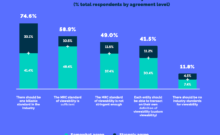Most marketers agree that viewability is important, but few agree on how it should be defined.
The CMO Council surveyed 233 senior marketers worldwide in the first quarter of 2018 and found that few respondents are completely fine with the Interactive Advertising Bureau’s viewability guidelines, which refer to Media Rating Council (MRC) standards that rate video ads as viewable as long as 50% of the ad is on screen for at least 2 consecutive seconds. While it’s easy to disagree with the status quo, coming up with solutions is more difficult. More than four in 10 respondents said they disagree with the industry standard, but admitted that they struggled to find a better viewability definition.
The way viewability is defined can have a big impact on campaign billing since advertisers use their programmatic buying platforms to restrict their media spend to inventory that is highly viewable. For instance, ad buying firm GroupM uses strict viewability standards, which require that 100% of an ad’s pixels be in view. While advertisers support stricter standards, publishers complain that they’re not fairly compensated for reaching high viewability benchmarks.
“We wrote the viewability standard to apply to the whole industry,” said MRC CEO and executive director George Ivie. “If you asked the same question of the sell side, you might see similarly questioning results, for exactly the opposite reasons. It’s this balancing of interests that makes it difficult to set standards for an entire industry, and this study wouldn’t be able to tell us whether we’ve achieved an appropriate balance here.”
In March, the MRC issued a call for public research to see if it should raise its viewability criteria to require 100% of an ad’s pixels to be in-view in order to be counted viewable. About 30% of the 816 US digital media professionals surveyed by Integral Ad Science in December 2017 said they use their own viewability standards.
Read More at The Original Article: www.emarketer.com









